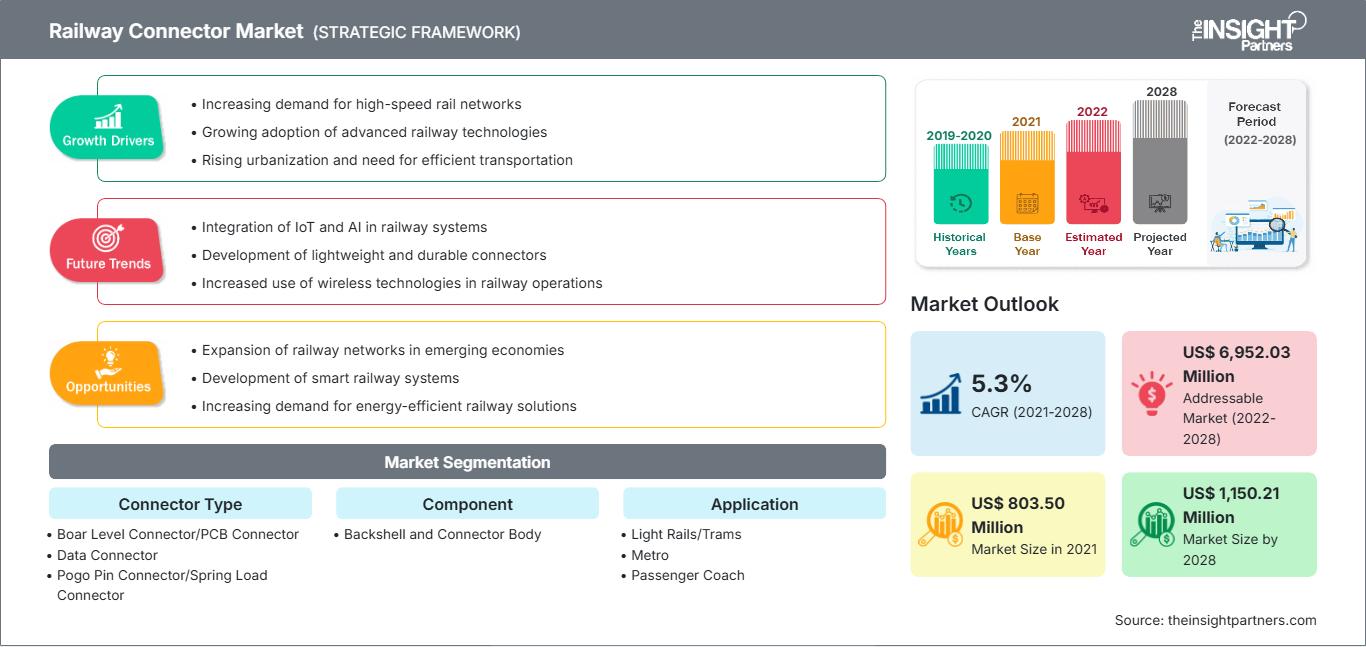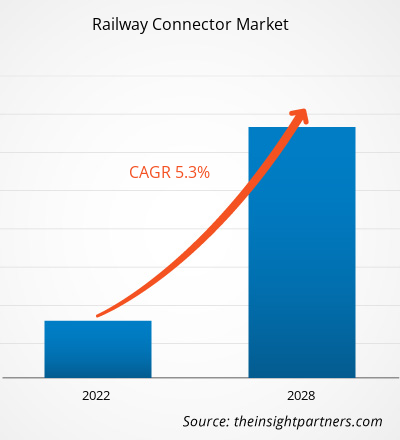Si prevede che il mercato dei connettori ferroviari crescerà da 803,50 milioni di dollari nel 2021 a 1.150,21 milioni di dollari entro il 2028; si stima una crescita a un CAGR del 5,3% dal 2021 al 2028.
La crescita demografica, il cambiamento dello stile di vita e la rapida urbanizzazione richiedono un sistema di comunicazione ferroviaria interconnesso e ne guidano la crescita del mercato. Inoltre, l'aumento della velocità di trasmissione dati e la crescente tendenza alla miniaturizzazione dei dispositivi elettronici stimolano lo sviluppo di soluzioni di comunicazione compatte, robuste e ad alta velocità. L'emergere di reti di trasmissione digitale sulle ferrovie pone i produttori di fronte alla sfida di sviluppare concetti di sistema e interfacce per apparecchiature adatti alla comunicazione di dati complessi. Molti veicoli europei sono dotati di tecnologie avanzate, come la trasmissione dati wireless, che si prevede stimoleranno la domanda di connettori ferroviari per la comunicazione di dati complessi in Europa durante il periodo di previsione.
Personalizza questo rapporto in base alle tue esigenze
Potrai personalizzare gratuitamente qualsiasi rapporto, comprese parti di questo rapporto, o analisi a livello di paese, pacchetto dati Excel, oltre a usufruire di grandi offerte e sconti per start-up e università
Mercato dei connettori ferroviari: Approfondimenti strategici

-
Ottieni le principali tendenze chiave del mercato di questo rapporto.Questo campione GRATUITO includerà l'analisi dei dati, che vanno dalle tendenze di mercato alle stime e alle previsioni.
Impatto della pandemia di COVID-19 sul mercato dei connettori ferroviari
Nel 2020, la pandemia di COVID-19 ha avuto un impatto negativo su larga scala sulle economie globali. La pandemia ha portato a numerose sfide in diversi mercati, come il mercato dei connettori ferroviari. La domanda e l'offerta hanno subito una forte riduzione a causa della bassa produzione. Inoltre, il settore ferroviario ha subito un impatto negativo a causa del lockdown. Le restrizioni alla catena di approvvigionamento hanno causato un arresto della produzione di connettori ferroviari in tutto il mondo. Tuttavia, le prospettive per i progetti ferroviari sono rimaste positive nel 2021. Pertanto, la domanda di connettori ferroviari è aumentata a partire dal 2021.
Approfondimenti di mercato - Mercato dei connettori ferroviari
L'avvento dei treni senza conducente darà impulso al mercato dei connettori ferroviari durante il periodo di previsione
La crescente elettrificazione nel settore dei trasporti globale, indipendentemente dalla modalità di trasporto, ha portato allo sviluppo di metodi di trasporto automatizzati. I treni sono i pionieri dell'automazione dei trasporti dopo il trasporto su strada, poiché la guida autonoma sta facendo il suo ingresso nel settore ferroviario. In Europa, il funzionamento automatico dei treni (ATO) sta diventando l'ultima tendenza che modernizza il settore ferroviario della regione. Nell'ottobre 2019, sei aziende tedesche, guidate da Siemens Mobility, hanno avviato un progetto congiunto denominato "AStriD". La crescita del trasporto urbano e locale richiede l'integrazione di sistemi avanzati e automatizzati nel settore ferroviario per ottimizzare le operazioni ferroviarie. Pertanto, la crescente domanda di connettori nei treni autonomi offre vantaggi agli operatori che operano nel mercato dei connettori ferroviari.
Approfondimenti basati sulla tipologia di connettore
In base alla tipologia di connettore, il mercato dei connettori ferroviari è segmentato in connettori di livello generale/connettori PCB, connettori dati, connettori pogo pin/connettori a molla, connettori di alimentazione e altri. Il segmento dei connettori di livello generale/connettori PCB ha detenuto la quota di mercato maggiore nel 2021.
Gli operatori che operano nel mercato dei connettori ferroviari si concentrano principalmente sullo sviluppo di prodotti avanzati ed efficienti.
- A gennaio 2021, Fischer Connectors Group ha avviato la costruzione di un nuovo stabilimento produttivo in Portogallo.
- A giugno 2021, AB Connectors di TT Electronics è diventata membro Gold del forum ferroviario Midlands.
Le tendenze regionali e i fattori che influenzano il mercato dei connettori ferroviari durante il periodo di previsione sono stati ampiamente spiegati dagli analisti di The Insight Partners. Questa sezione illustra anche i segmenti e la geografia del mercato dei connettori ferroviari in Nord America, Europa, Asia-Pacifico, Medio Oriente e Africa, America Meridionale e Centrale.
Ambito del rapporto sul mercato dei connettori ferroviari
| Attributo del rapporto | Dettagli |
|---|---|
| Dimensioni del mercato in 2021 | US$ 803.50 Million |
| Dimensioni del mercato per 2028 | US$ 1,150.21 Million |
| CAGR globale (2021 - 2028) | 5.3% |
| Dati storici | 2019-2020 |
| Periodo di previsione | 2022-2028 |
| Segmenti coperti |
By Tipo di connettore
|
| Regioni e paesi coperti |
Nord America
|
| Leader di mercato e profili aziendali chiave |
|
Densità degli operatori del mercato dei connettori ferroviari: comprendere il suo impatto sulle dinamiche aziendali
Il mercato dei connettori ferroviari è in rapida crescita, trainato dalla crescente domanda degli utenti finali dovuta a fattori quali l'evoluzione delle preferenze dei consumatori, i progressi tecnologici e una maggiore consapevolezza dei vantaggi del prodotto. Con l'aumento della domanda, le aziende stanno ampliando la propria offerta, innovando per soddisfare le esigenze dei consumatori e sfruttando le tendenze emergenti, alimentando ulteriormente la crescita del mercato.

- Ottieni il Mercato dei connettori ferroviari Panoramica dei principali attori chiave
Il mercato dei connettori ferroviari è segmentato in base al tipo di connettore, al componente, all'applicazione e all'area geografica. In base al tipo di connettore, il mercato è segmentato in connettori a livello generale/connettori PCB, connettori dati, connettori pogo pin/connettori a molla, connettori di alimentazione e altri. Nel 2021, il segmento dei connettori a livello generale/connettori PCB ha guidato il mercato e ha rappresentato la quota di mercato maggiore. In base al componente, il mercato è suddiviso in guscio posteriore e corpo del connettore. Nel 2021, il segmento del corpo del connettore ha guidato il mercato e ha rappresentato una quota di mercato maggiore. In base all'applicazione, il mercato dei connettori ferroviari è segmentato in metropolitana leggera/tram, metropolitana, carrozze passeggeri e altri. Nel 2021, il segmento "altri" ha guidato il mercato e ha rappresentato la quota di mercato maggiore. Geograficamente, il mercato è ampiamente segmentato in Nord America, Europa, Asia Pacifico (APAC), Medio Oriente e Africa (MEA) e Sud America (SAM). Nel 2021, l'area Asia-Pacifico ha rappresentato una quota significativa del mercato globale dei connettori ferroviari.
Amphenol Corporation, Kyocera-AVX, Fischer Connectors SA, Harting Technology Group, Molex, LLC (Koch Industries, Inc.), Schaltbau GmbH, Allied Electronics Corporation, Smiths Interconnect, TE Connectivity Corporation e TT Electronics sono tra i principali attori profilati in questo studio di mercato. Inoltre, sono stati studiati e analizzati diversi altri attori essenziali del mercato per ottenere una visione olistica del mercato dei connettori ferroviari e del suo ecosistema.
- Analisi storica (2 anni), anno base, previsione (7 anni) con CAGR
- Analisi PEST e SWOT
- Valore/volume delle dimensioni del mercato - Globale, Regionale, Nazionale
- Industria e panorama competitivo
- Set di dati Excel
Report recenti
Rapporti correlati
Testimonianze
Motivo dell'acquisto
- Processo decisionale informato
- Comprensione delle dinamiche di mercato
- Analisi competitiva
- Analisi dei clienti
- Previsioni di mercato
- Mitigazione del rischio
- Pianificazione strategica
- Giustificazione degli investimenti
- Identificazione dei mercati emergenti
- Miglioramento delle strategie di marketing
- Aumento dell'efficienza operativa
- Allineamento alle tendenze normative






















 Ottieni un campione gratuito per - Mercato dei connettori ferroviari
Ottieni un campione gratuito per - Mercato dei connettori ferroviari